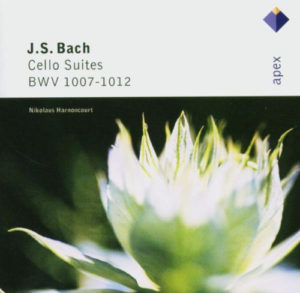
Nikolaus Harnoncourt. Bach Cello Suites. CD reissue 2003 on apex 2564 608816-2.
Cellos played by: Andrea Castagneri 1744 (Suites 1-5) and for 6thSuite Violoncello piccolo by Baer Salzburg mid 17thCentury.
Recorded by The Musical Heritage Society and originally released on vinyl 1965.
Introduction.
Firstly, it pains me to say that this is a poor quality recording technically. The sound is very “boxy” and two dimensional with no sense of space or positioning of the cello. What dynamics are expressed by the performer seem limited by the recording dynamic range.
There is “noise” constantly in the background at a low level but intrusive. I could not work out whether it was mechanical from the tape recorder or digital from a poor transfer to CD. Of course this is a recording from the 60s, but there are plenty of fine recordings from this era. Examples being, the Janos Starker Mercury recordings and Tortelier’s first recording of the Suites on EMI.
This recording was made and released by The Musical Heritage Society which appears to have been a low budget subscription based organisation. To its credit their remit was to promote Baroque music especially. In addition to possibly made recordings cheaply on commission for artists. Unfortunately, I was unable to unearth much more from internet searching, but no doubt more detailed background information can be found by those so inspired!
The Music.
What about the performance itself?
To quote the excellent notes supplied by Nicholas Anderson describing the significance of this recording:
“ …when the pursuit of an ideal nurtured by a historically aware performance style was in its infancy. ….. Harnoncourt’s interpretation of this music, … vividly reflects a crucial and fascinating stage in the evolutionary process. ….occupying middle ground between the traditional performances of Pablo Casals, … Paul Tortelier, and the historically orientated period instrument approach of Anner Bylsma….. and the present young generation of Baroque cellists.”
Other releases of this recording do mention the Anna Magdalena manuscript as being the written basis of Harnoncourt’s interpretation.
Phrasing and shaping.
I admire much about the phrasing and shaping of the music. Most tempos are close to the norm. However, the third Allemande strikes me as being somewhat dirge like. Some of the Sarabandes are quite brisk. In addition, unlike many performers, Harnoncourt plays without rubato and with a slight swing to emphasise their dance origins.
The sound of the violincello piccolo used for the sixth suite fascinates. It sounds very different but unfortunately not very beguiling to my ears! I have to say it sounds like a cheap viola!
Conclusion.
So, sadly, whilst this is a performance worthy of attention due to its historical and musical interest, it is let down badly by its recording quality. If you are an avid listener to Baroque Cello, I suspect you will already have this recording in some form. If you are building a library of such recordings, I would investigate some of the early vinyl releases which may be devoid of any contribution from digital distortion. They are still available at reasonable prices.
Charles.